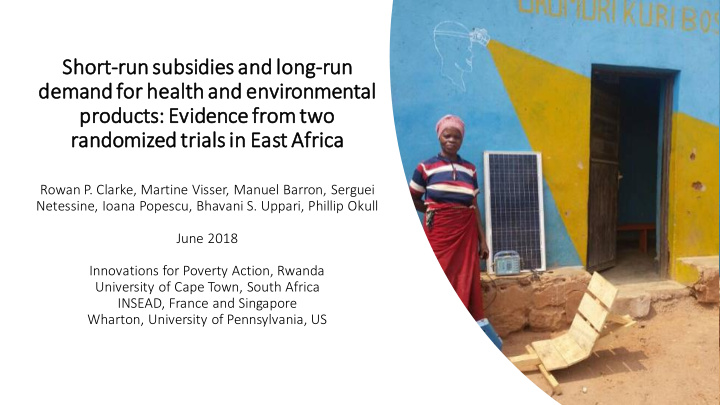



Shor hort-run un subs bsidie dies and nd long ng-run un demand nd fo for healt lth and nd envir nviron onmental l prod oduc ucts: Evid idence from om two wo rando ndomiz ized d tria ials ls in East Afric ica Rowan P. Clarke, Martine Visser, Manuel Barron, Serguei Netessine, Ioana Popescu, Bhavani S. Uppari, Phillip Okull June 2018 Innovations for Poverty Action, Rwanda University of Cape Town, South Africa INSEAD, France and Singapore Wharton, University of Pennsylvania, US
Background • Majority of households are not connected in Rwanda – only 37% connected nationally • Pneumonia is the leading cause of death - indoor air pollution from kerosene smoke is a major risk factor (Barron & Torero, 2017) • The proposed solution is for-profit distribution of solar • Yet adoption of such technologies remains low • Preliminary evidence that most households are unable to afford even the cheapest lights (Grimm et al, 2016b; Barron, Clarke & Visser, 2017a). • Should for-profits or governments distribute lights? • What are the most effective pricing strategies? • How do one-off short-run subsidies affect long-run demand? • Subsidies are common but controversial in the development world
Experimental Design: Phase I • The study includes two separate randomized field experiments. • One randomly varying upfront price of lights • One randomly varying user fee • Phase I: lights are sold to consumers • Randomly assign discount vouchers • Goal: determine optimal pricing policy and impact on long-run use. • e.g., do households that paid for lights use them more?
Experimental Design: Phase I • Rural Huye, Rulindo, and Ruhango districts • 1987 households from 18 villages • Following the methodology of Cohen and Dupas (2010), Dupas (2014a), and Meredith et al, (2013). • Household level randomization • Prices include 0, 200, 300, 500, 800, 1000, 1500, 2000, and 3000 RWF
Data • Two data sources: • First, collected purchase information, voucher IDs, serial numbers. • Second, we specially develop remote data capturing technology using cellular GSM transmission. • This unique data collection technology allow us to measure actual usage rates, instead of relying on surveys • Surveys change behavior
Experimental Results: Short-run adoption, Phase I • The experimental results are shown in figure 1.
Take-up and price • We estimate the following equation 𝑘=3000 𝛾 𝑗𝑤 = 𝛾 0 + 𝑘=200 • 𝑍 𝑘 𝑄 𝑗𝑤𝑘 + 𝛿𝑊𝑗𝑚𝑚𝑏𝑓 𝑗𝑤 + 𝜁 𝑗𝑤 • Coefficient interpretation: percentage point reduction in demand compared to demand when the price is zero.
Take-up and price • At 500RWF ($0.67) demand drops significantly by 17.1 percentage points. • When 1000RWF ($1.33) is charged demand falls by 45 percentage points. • Other than 200, each price increase reduces demand further and is statistically significant with the highest price of 3000RWF ($4) reducing demand by 88 percentage points. • Looking at the R squared, we also see 40% of the variation in demand can be explained by price alone
Take-up and Price • Inline with literature on health products. • Price is the most important factor driving • Credit constrained or households simply do not value LEDs as much as their market price. • To ensure high take-up zero, or very low prices, are required
Conclusion • This study • estimates demand curves for both the initial price of low-cost LEDs as well as the subsequent user fee for repeated purchases • Estimates the impact of short-run subsidies on long-run demand. • We find uptake is highly sensitive to initial price. • Strong evidence that the initial upfront price of LEDs should be subsidized aligning with a new literature with the same results (Grimm et al., 2016).
Thank you!
Recommend
More recommend